December 19-21. This week, there was a mind-blowing 3-day experience of system thinking and organizational design modeling with Craig Larman. Having been at wide array of Craig’s training and public presentations in the past, I was still overwhelmed with volume of education that this class offered. One of the main distinctions ( imo – improvements) of this LeSS training from the previous, was the emphasis on hands-on system modeling by class participants, with the use of Causal Loop Diagrams (CLDs). Personally, being a huge fan and frequent user of CLDs,
I was able to graphically reinforce, once again, postulates of LeSS,
while modeling organizational design and inter-connecting system variables, as well as identifying which relationships are
Causation and which ones are Correlation.
Below, are some visuals that illustrate the course dynamics and working artifacts that were produced.
Class Kodak Moments:
Course Artifacts:
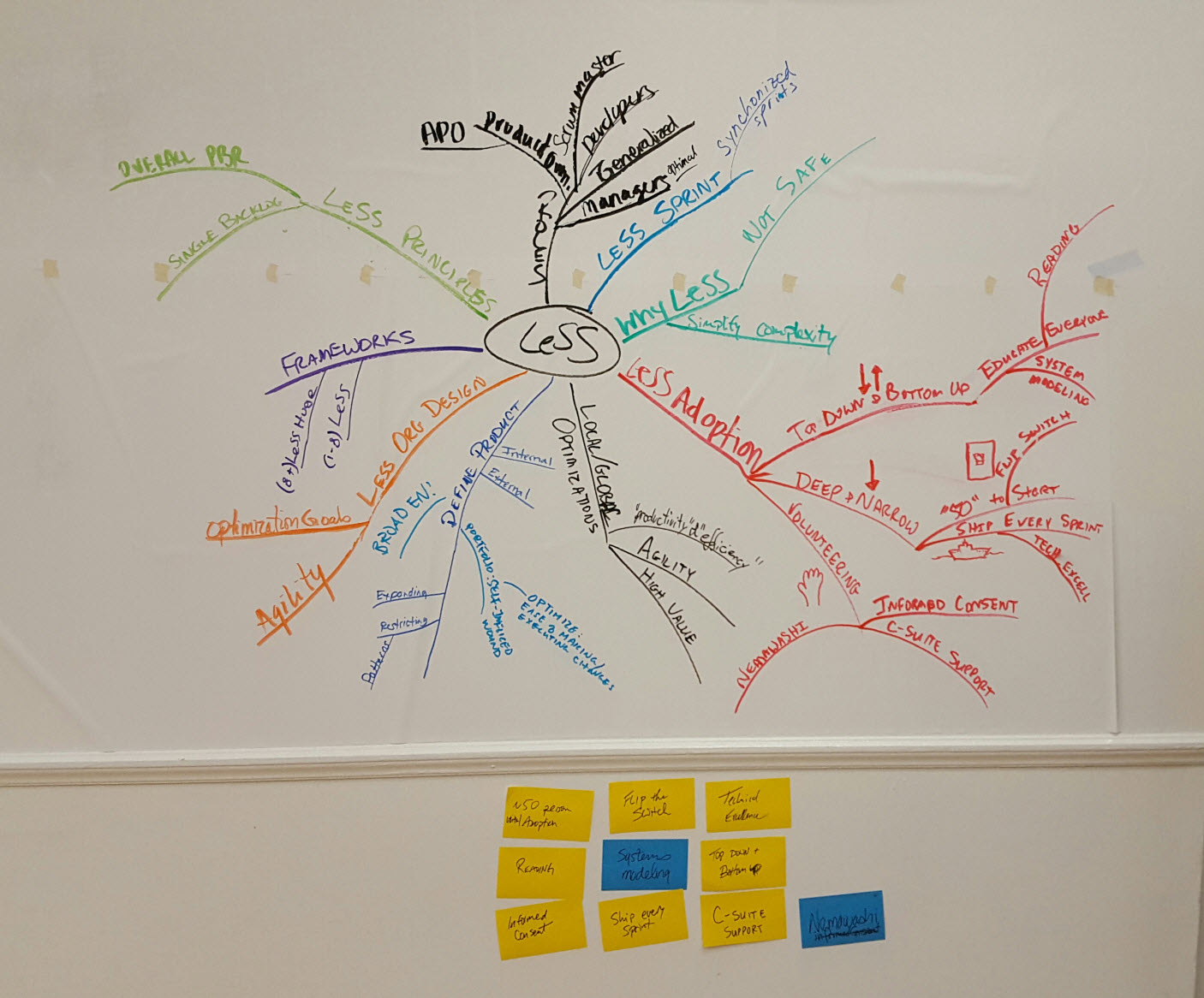 |
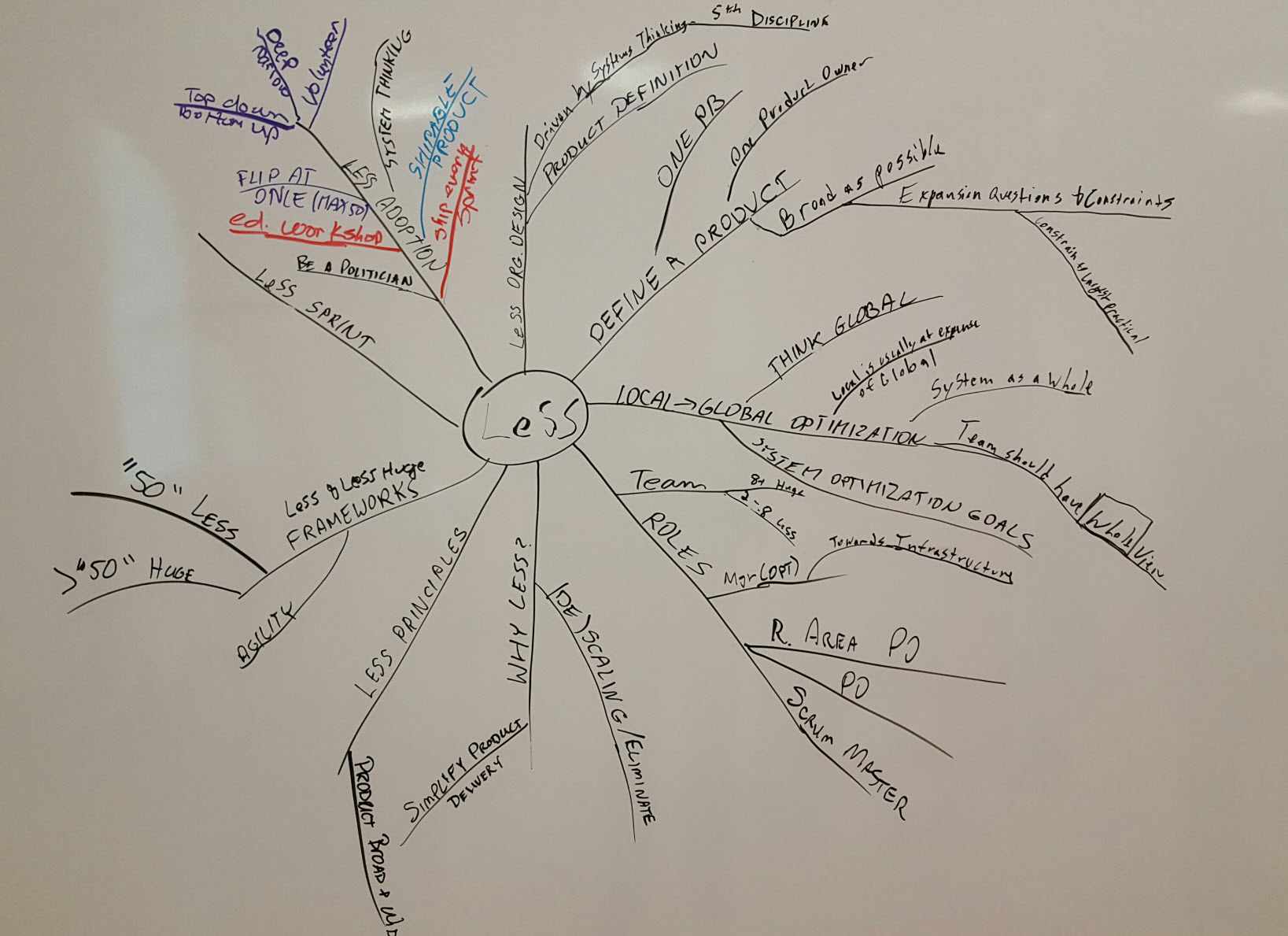 |
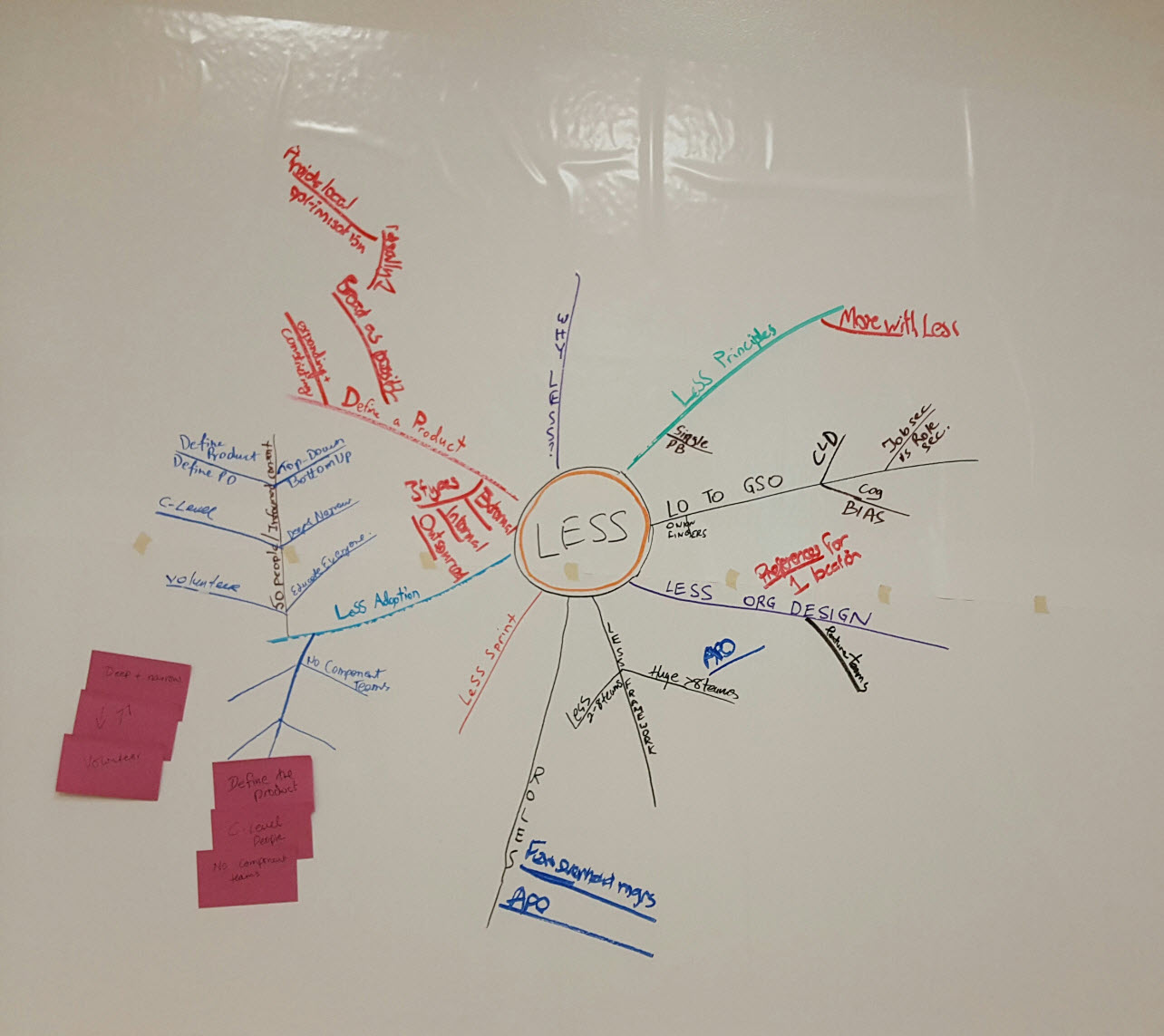 |
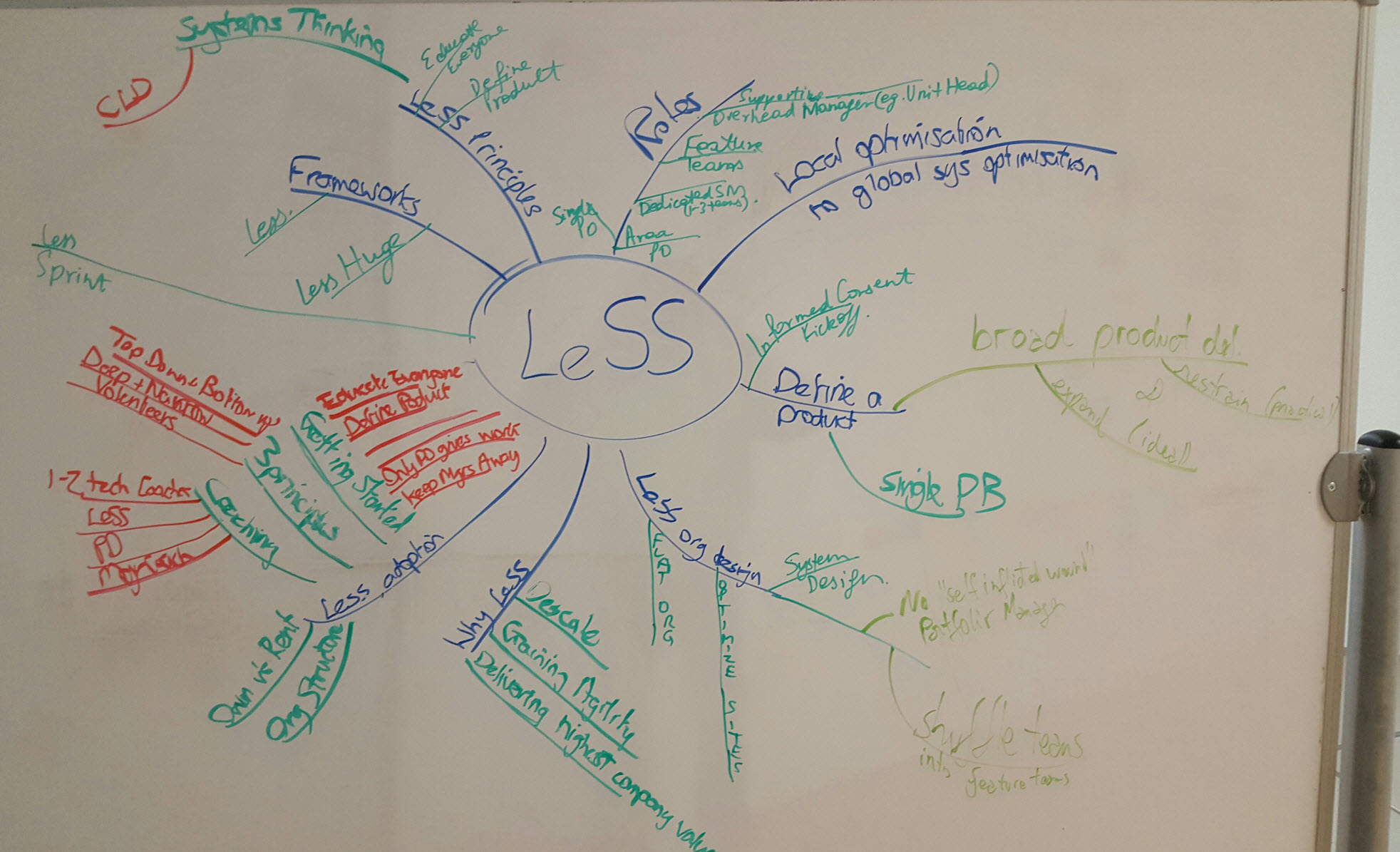 |
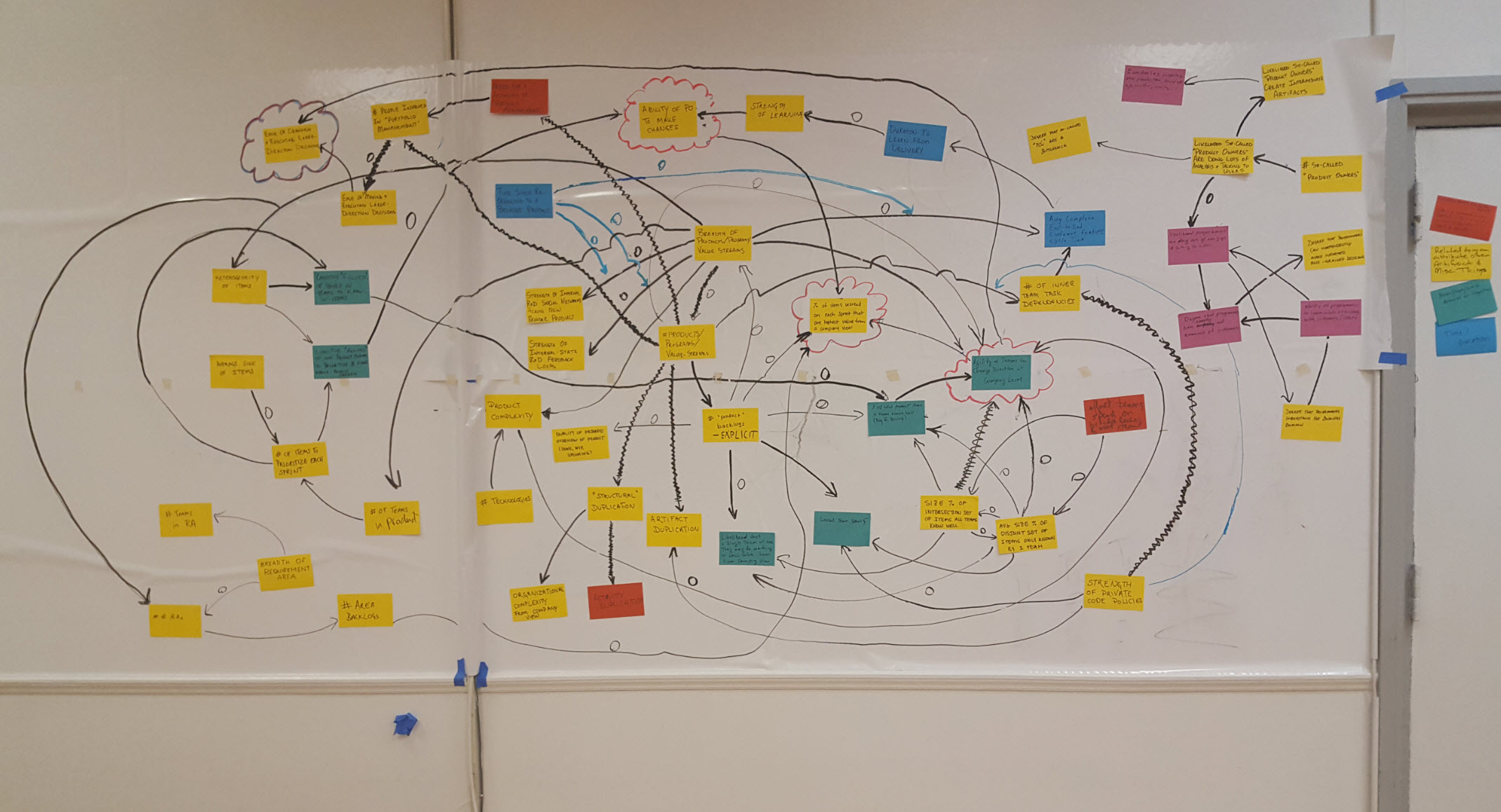 |
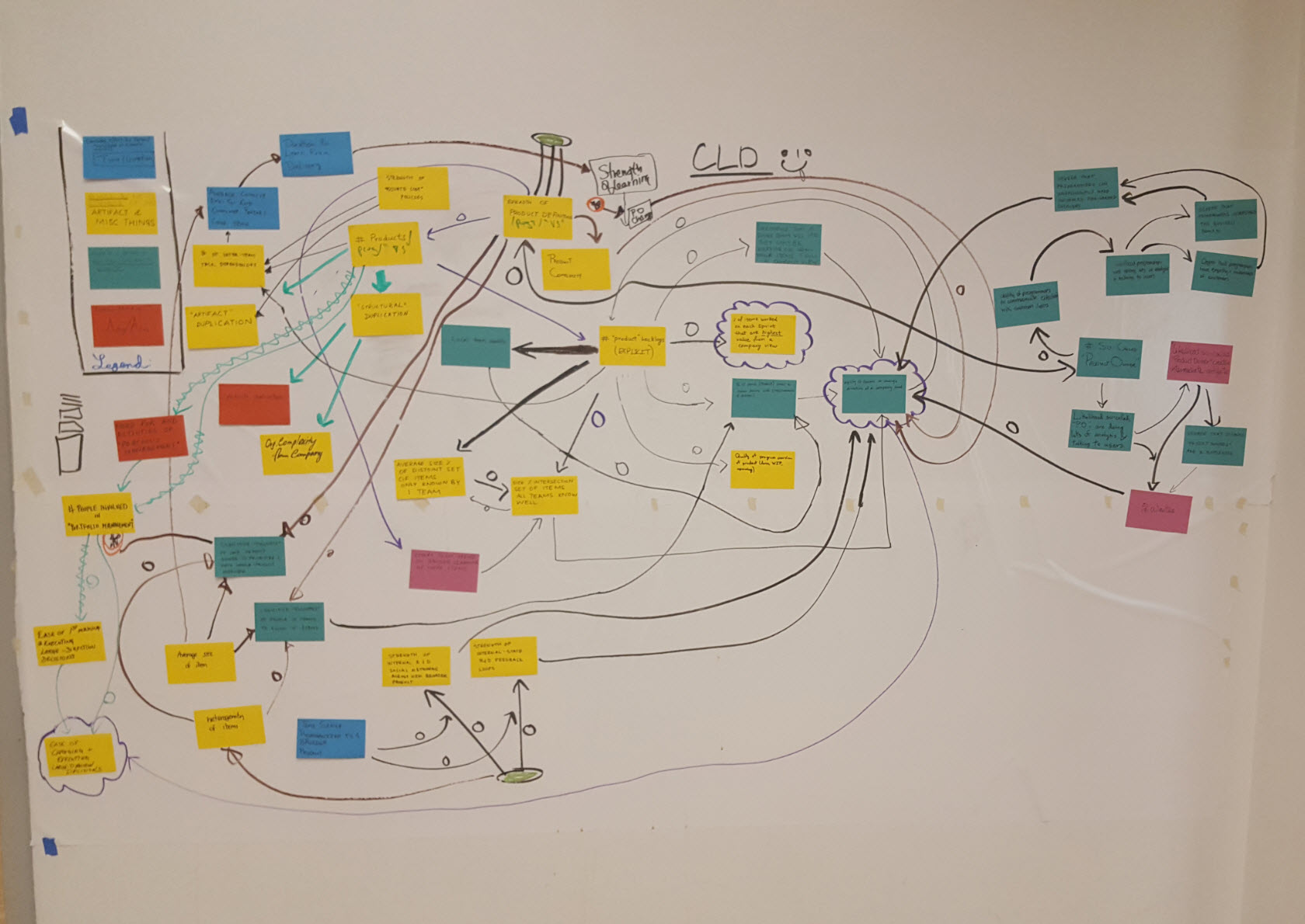 |
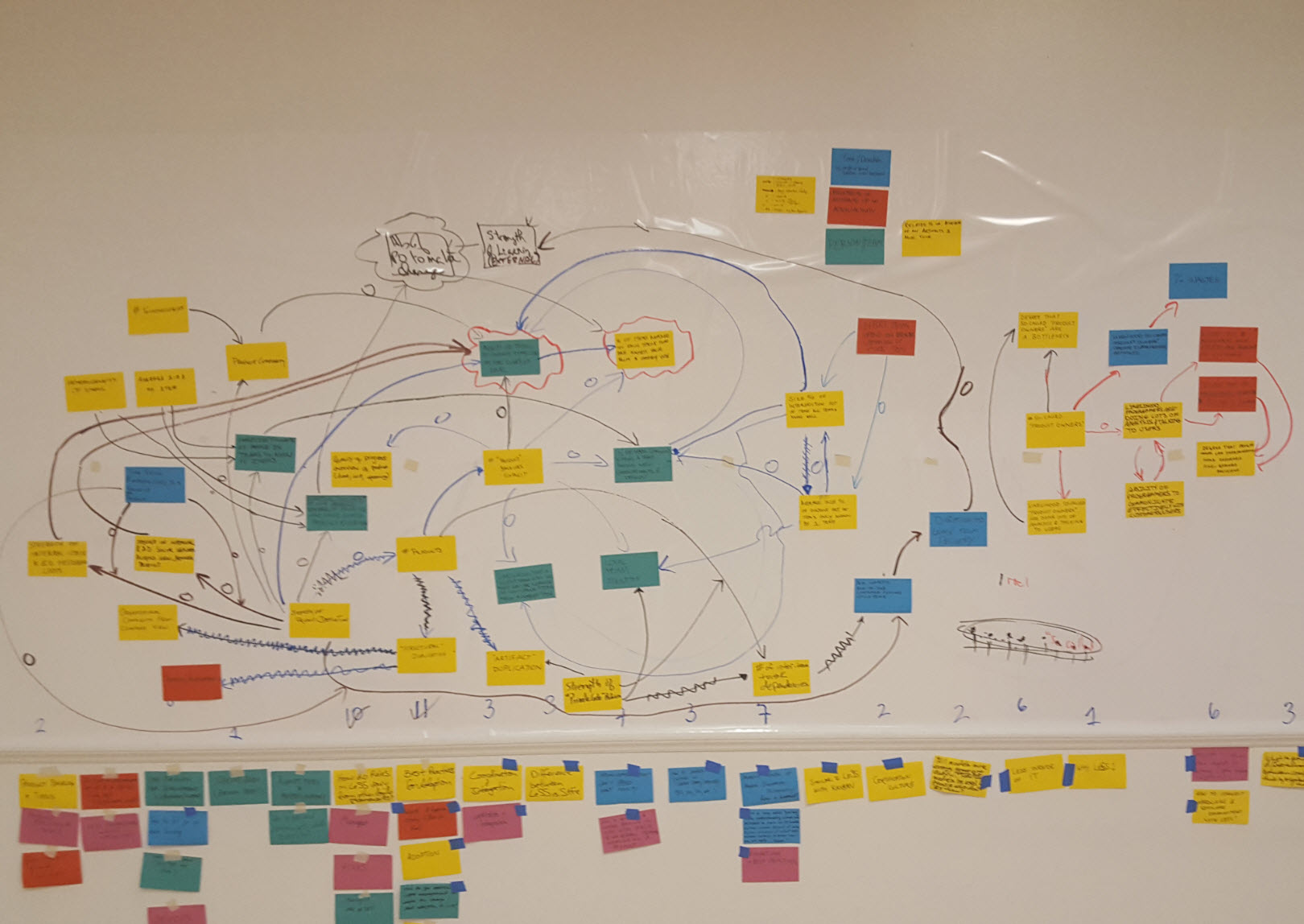 |
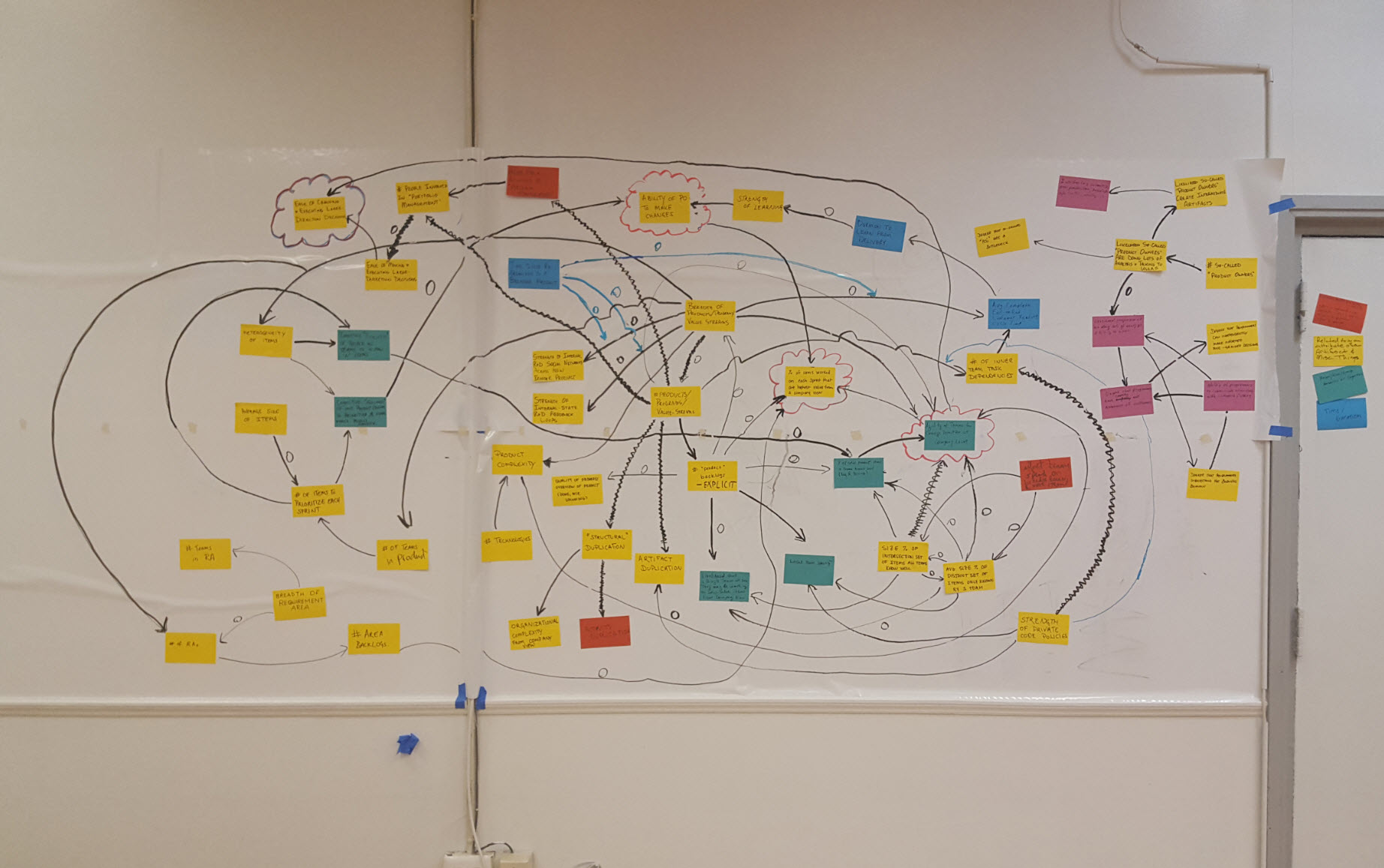 |
Course Highlights (personal):
- If we go back to history and recall how Agile Manifesto was originally created and naming chosen, “Agile” was never meant to describe ‘speed’, ‘efficiency’ and ‘cost effectiveness’. It was always meant to describe Adaptive-ness.
- To main goals of LeSS: to maximize Customer Value and ensure continuous learning
- Organizational Structure is one of the most important, 1st Order Factor that influences System Dynamics. (Some other 1st Order Factors are # of sites, group structures, organizational roles and hierarchies.)
- Many junior/unseasoned agile coaches give their clients a distorted coaching advice about agility, by recommending to focus only on 2nd and 3rd Order Factors (e.g. values, norms, culture) and omitting 1st Order Factors. By doing so, they (coaches) misguide clients to go after local manifested/superficial problems, while leaving real underlying, systemic issues unchallenged.
- Young, ambitious, career-seeking senior leaders that are in active pursuit of promotion are not the best supporters of agile transformations from within a company. Most likely, they will view agile as a way to fast-track their career and after 3-5 years of supporting the “movement” they will leave their role and move on. There is a high chance that someone, who takes over will “undo” what was done.
- While using Causal Loop Diagrams (CLDs) it is important to distinguish between Correlation and Causation relationships that connect Variables
- Team structure sub-optimization has multiple “dimensions”, e.g. too narrow-defined Products or teams built around Components
- As per TPS, Kaizen does not mean “small”
- Budgeting is rarely an issue in product companies. However, it is a BIG issue in internal development companies (e.g. banks)
- John Kotter (The Heart of Change): <paraphrasing>”… get skeptics and resistors out of the way…. there is a low chance they will support changes…”
- While delivering agile/scrum education, strive to focus on an entire team, not of separate roles (e.g. SM, Team, PO).
LeSS Meetup Kodak Moments:

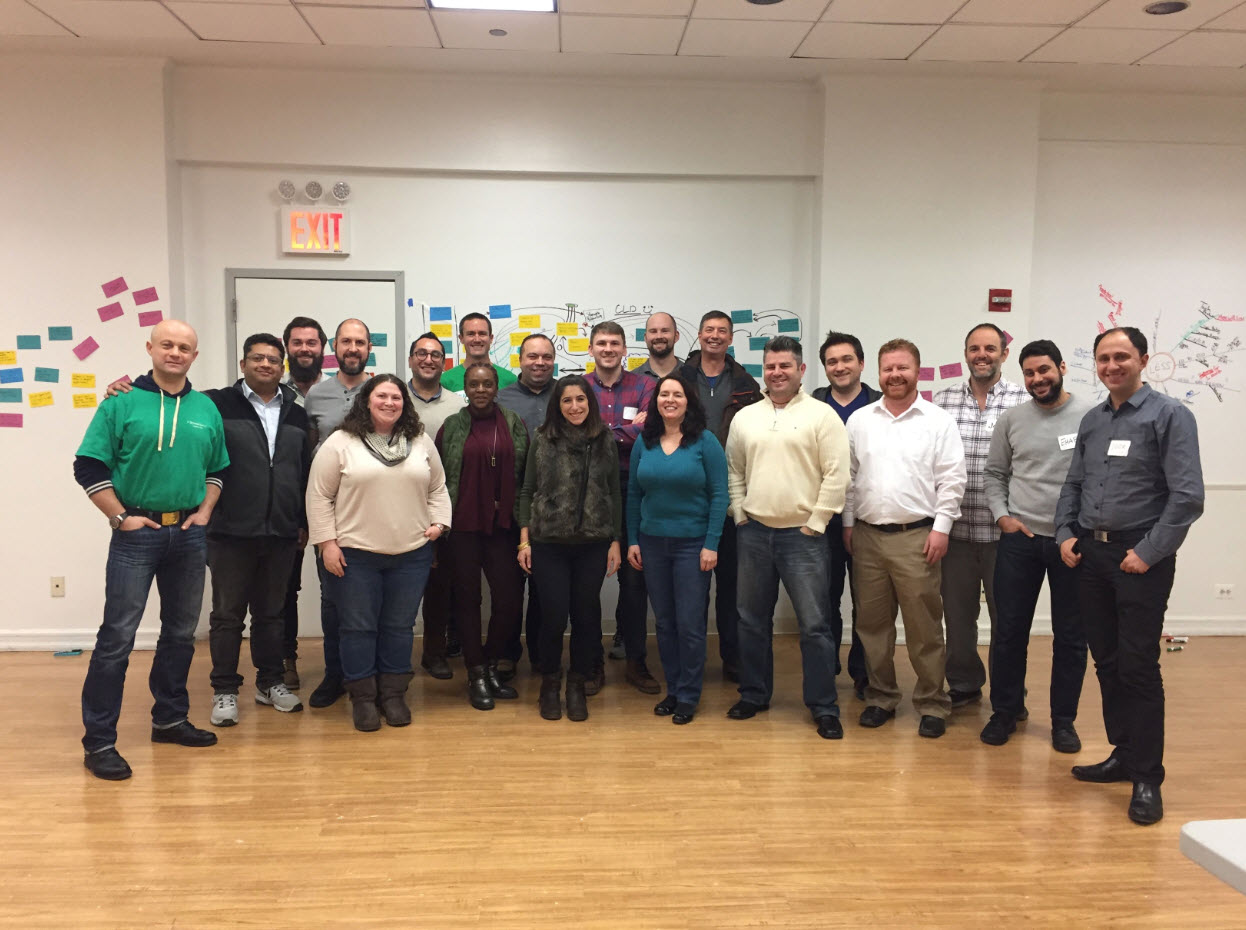
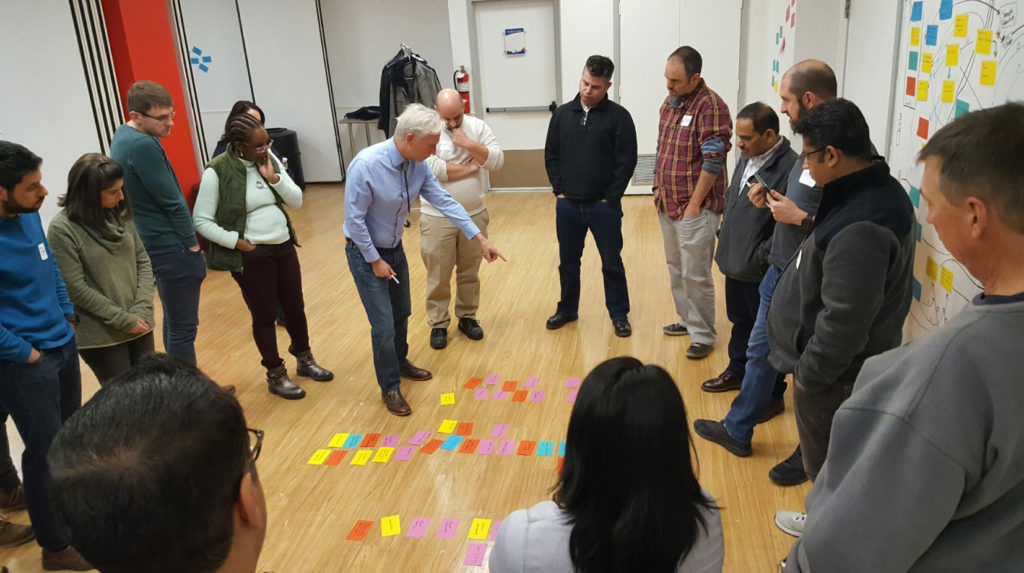
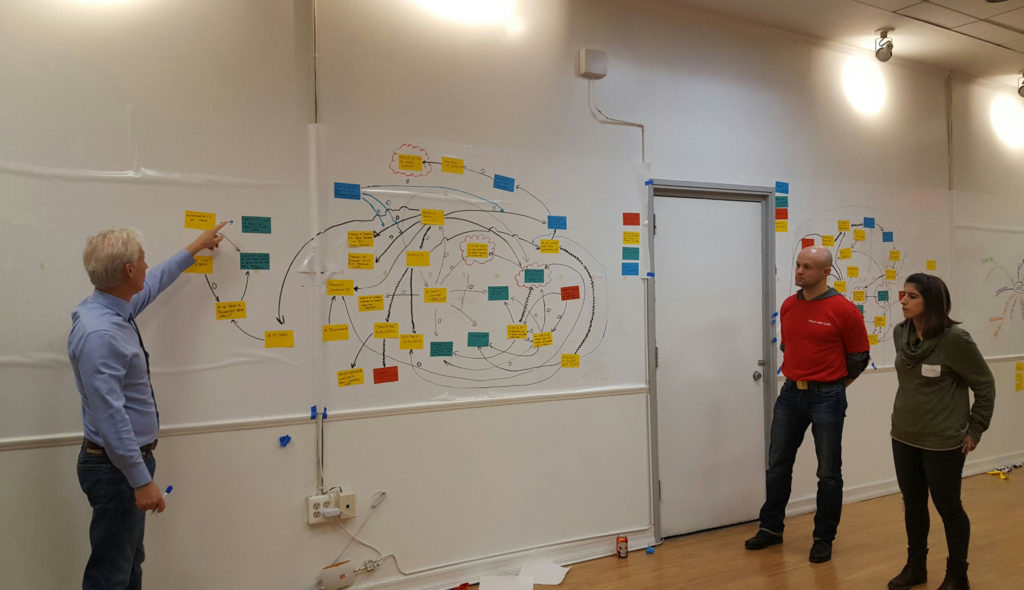
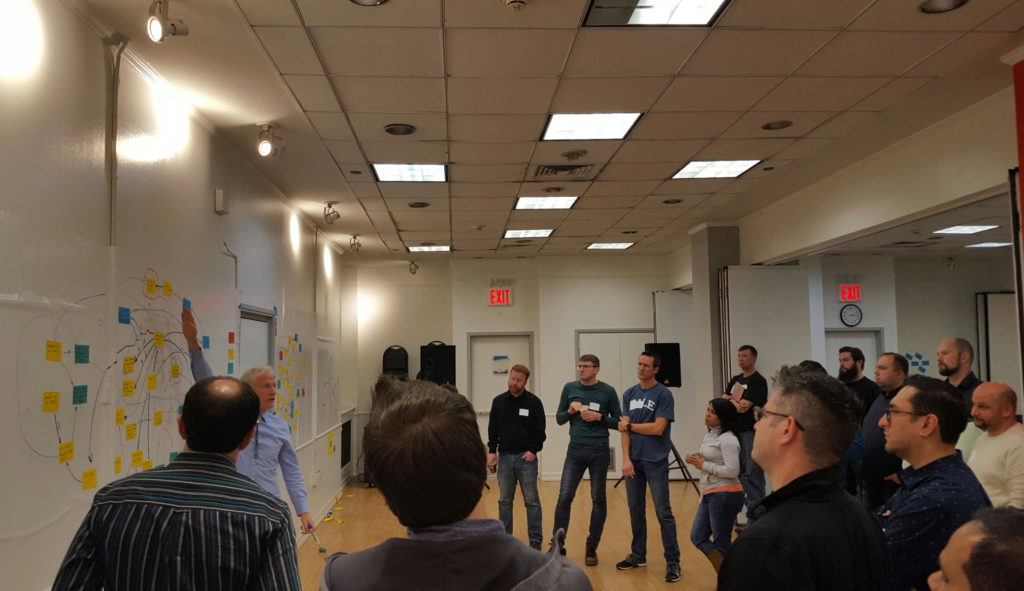
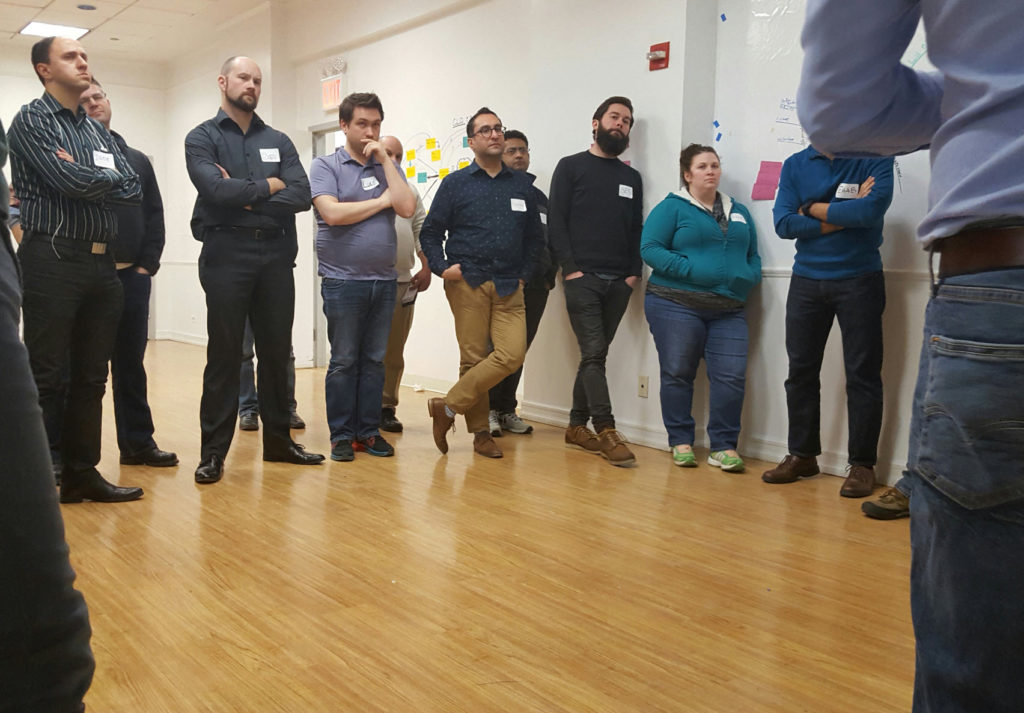
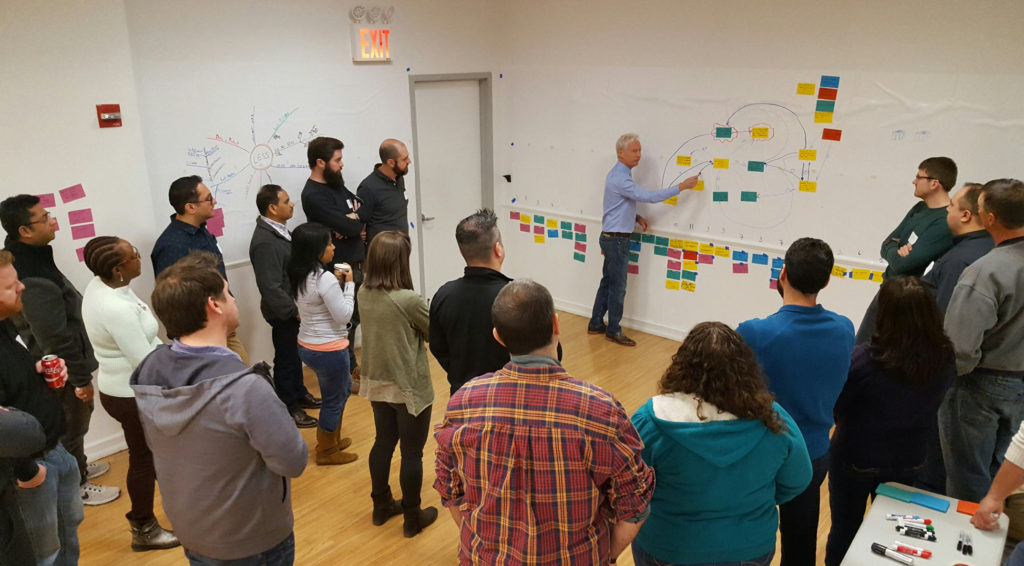
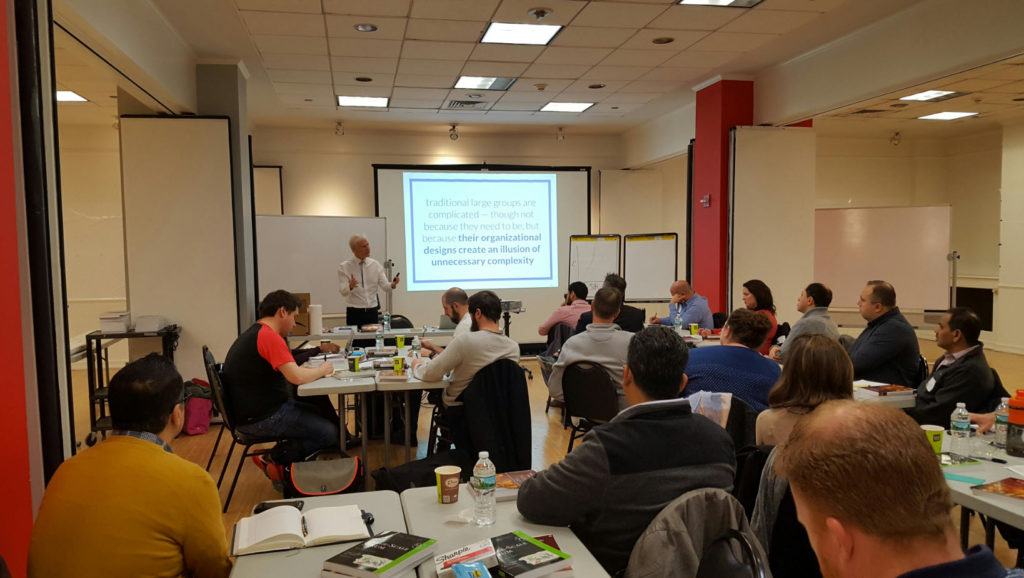
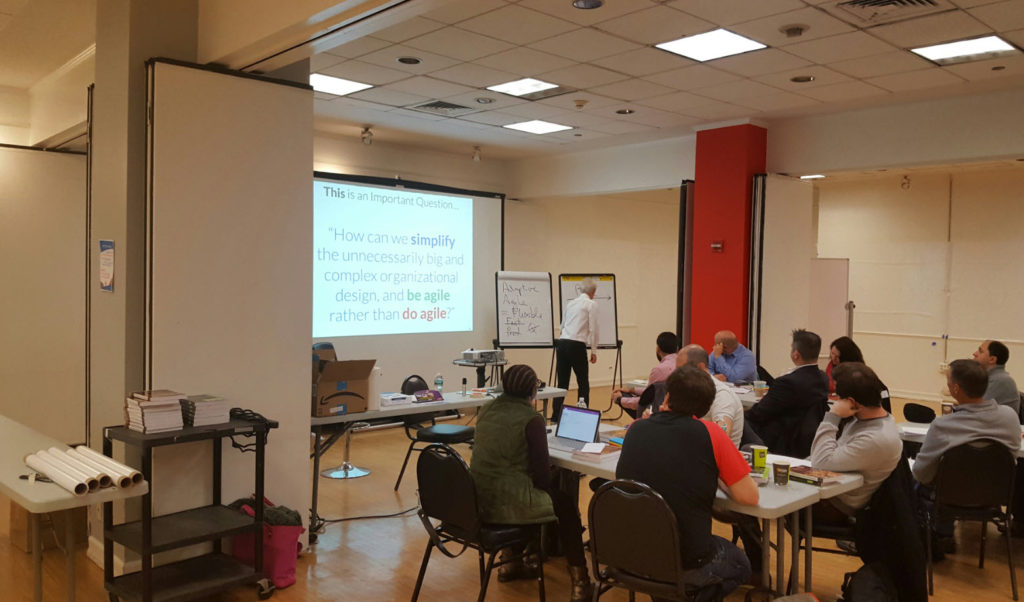
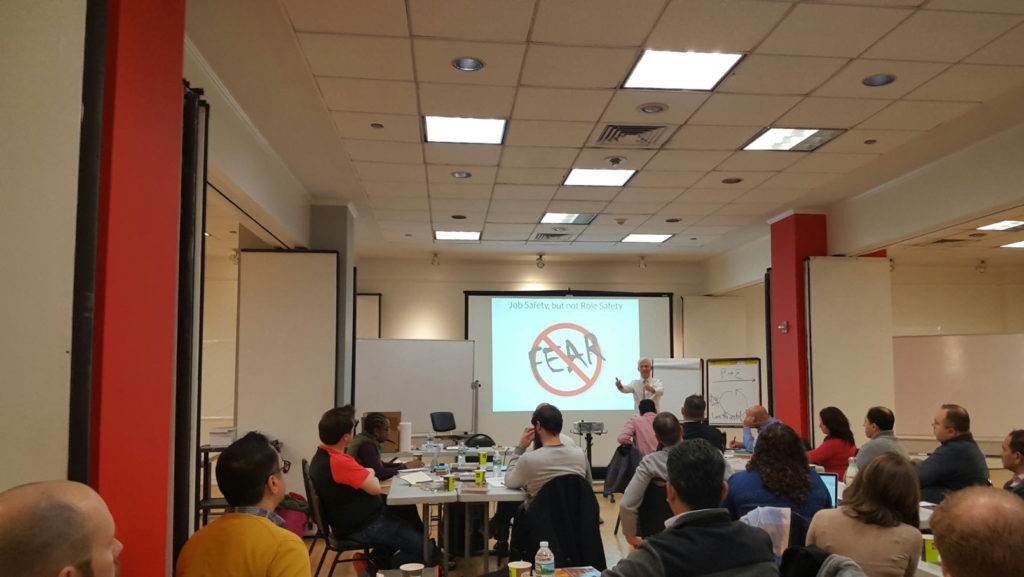
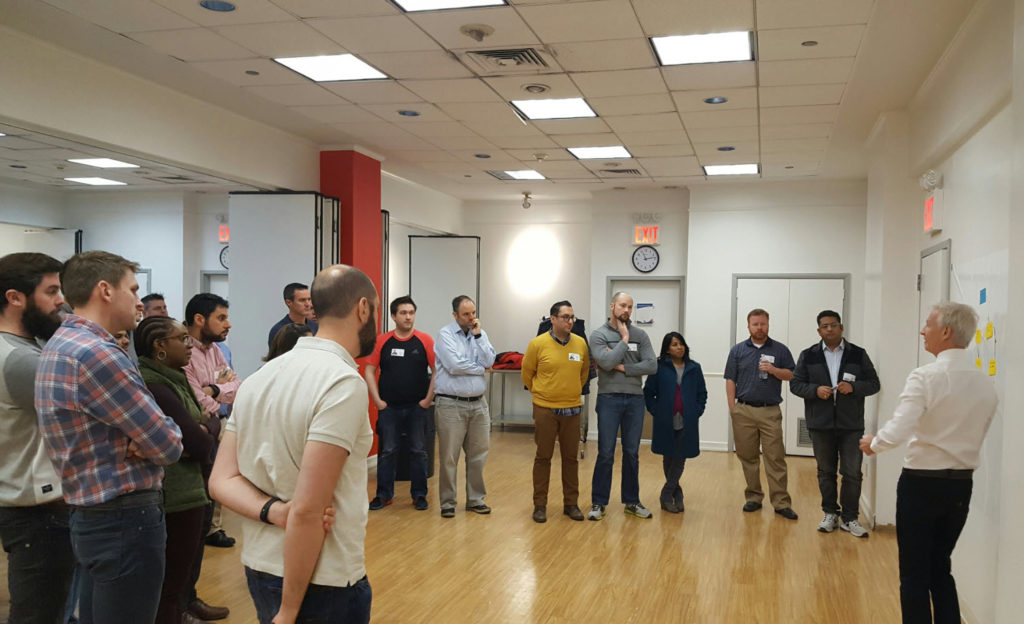
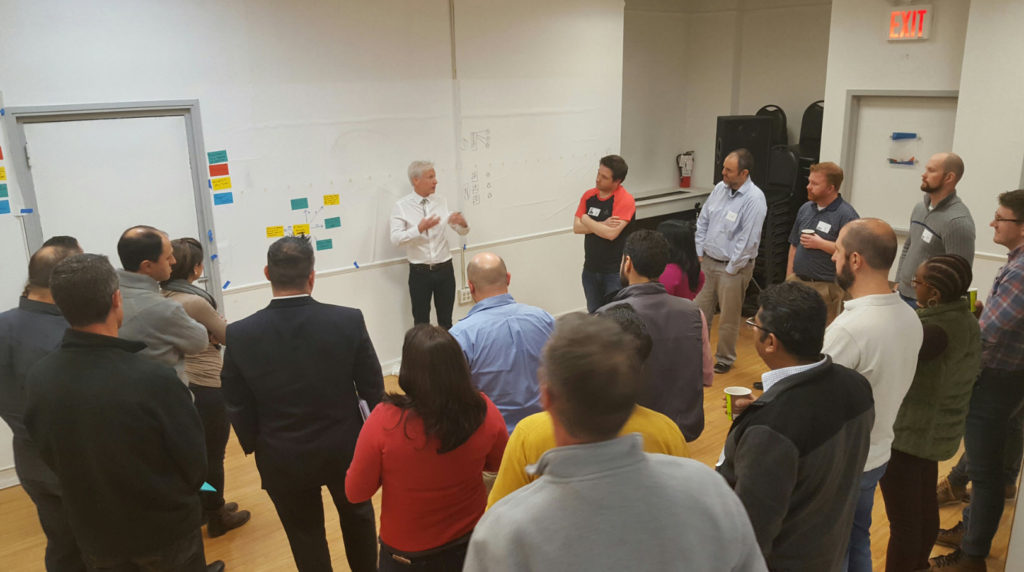
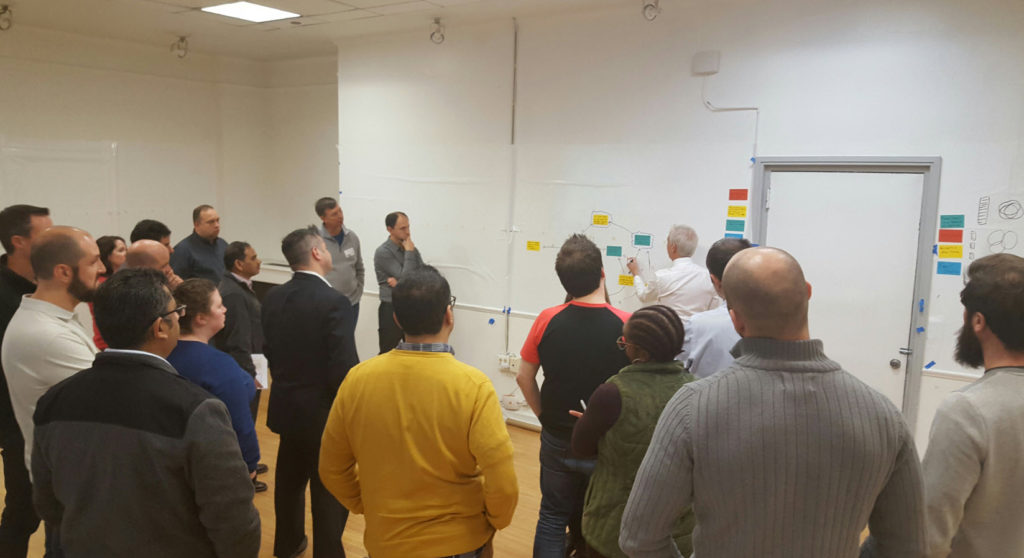
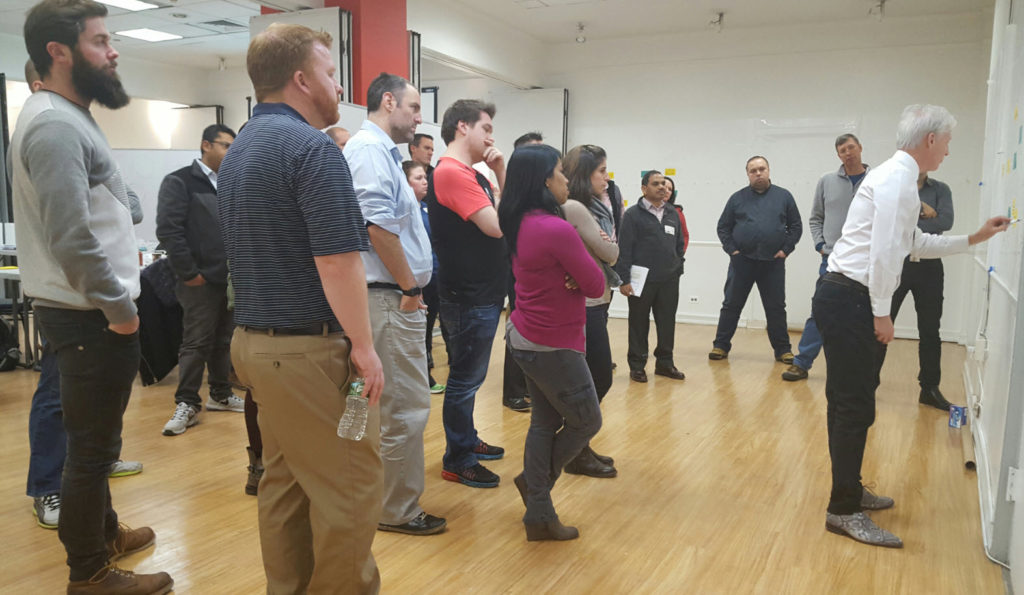
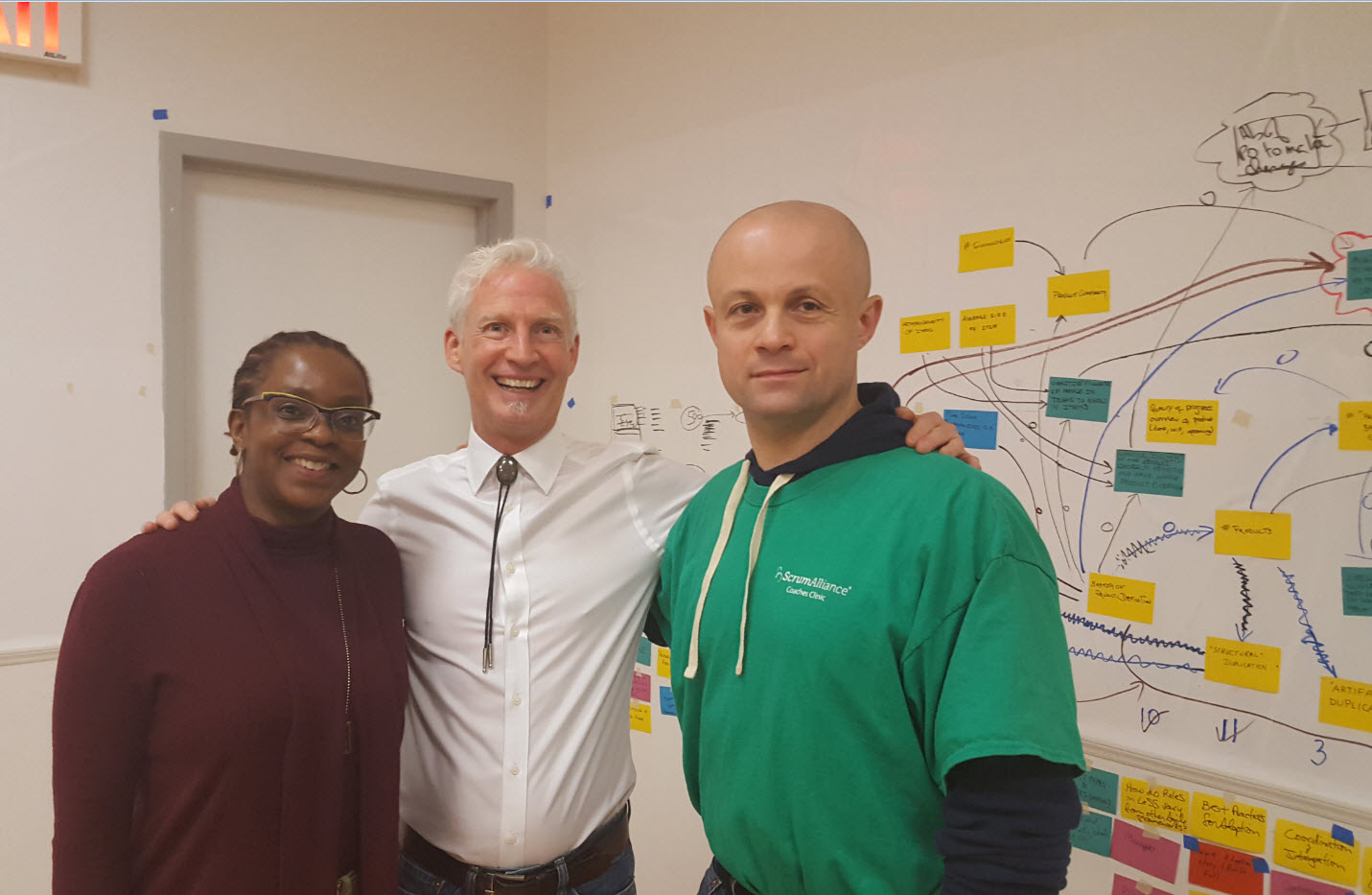
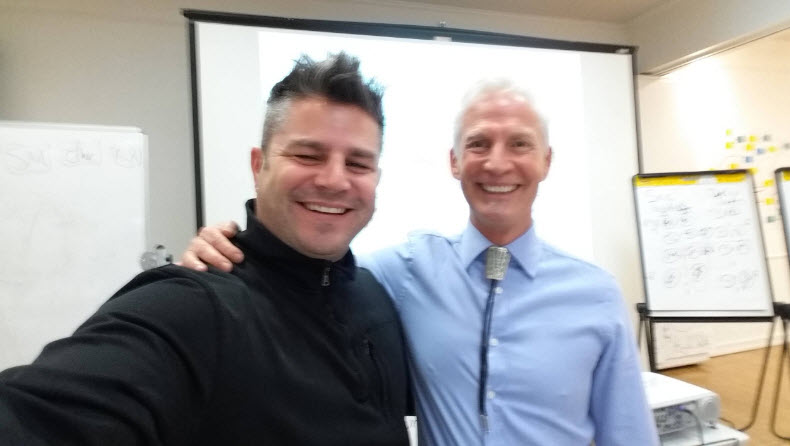
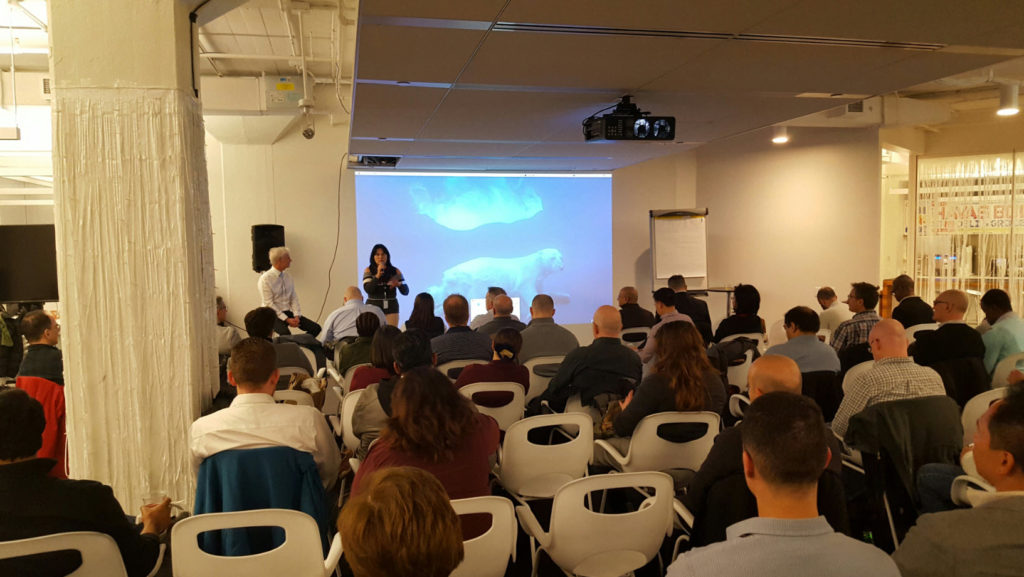
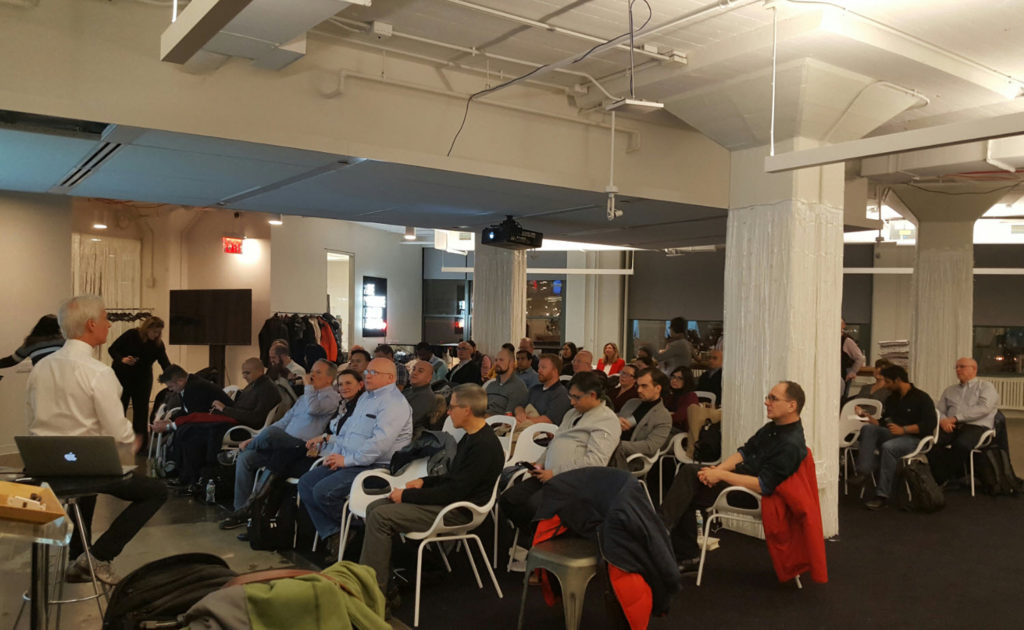
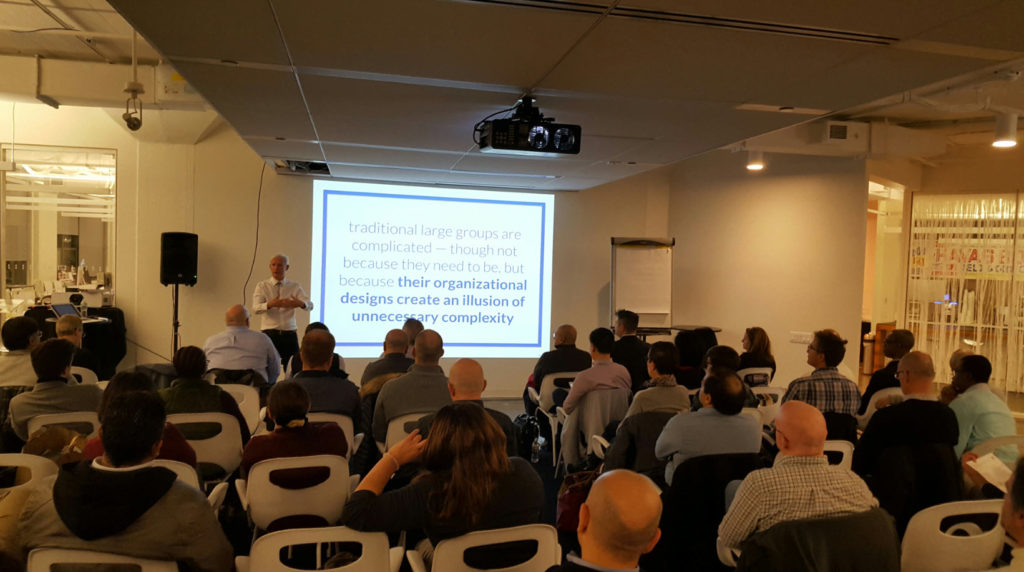
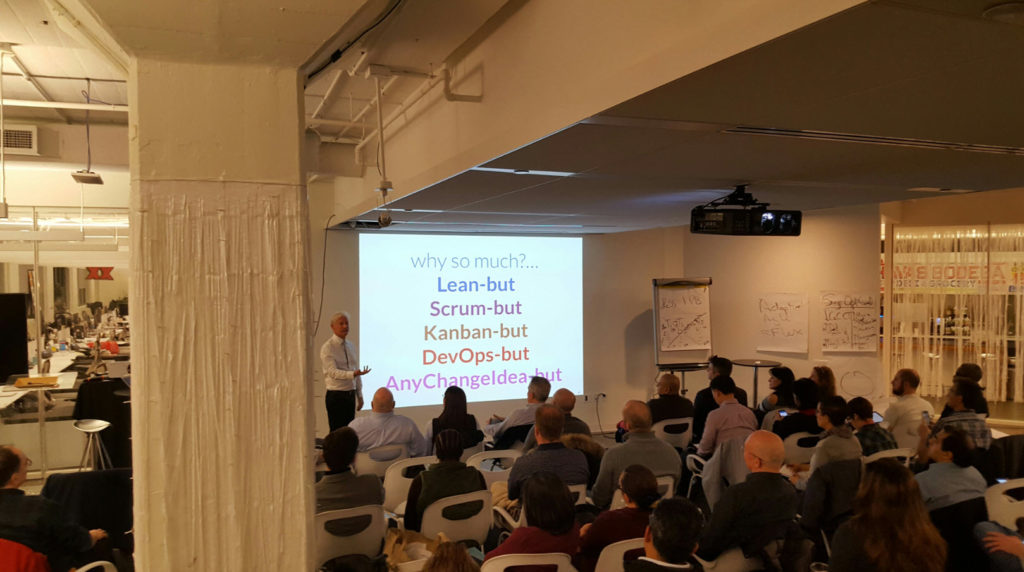
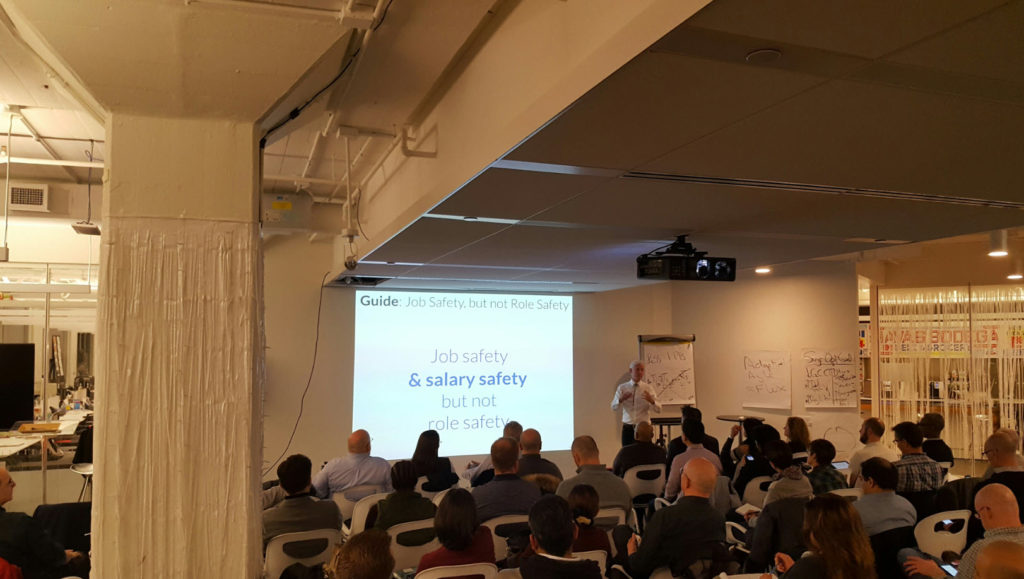
Yesterday , I’ve been lucky enough to be part of the event LeSS community of NYC organized by Gene G where Co-founder of Large Scale Scrum – Craig Larman engage us in a introduction discussion about system dynamics and system modeling in complex organizational settings.
While scaling is actually pretty simple to understand : organization should just let their self-organizing teams and tribes to decide what’s best for them, and trust them to improve their own work. It’s also TRUE and understandable that most senior and mid-managers are wary of letting go of all command and control. And ONLY for them LESS approach as framework helps the transition to be Agile in a painless and LESS structured process.
Well, I’ve just finished my second LeSS practitioner course. I have to say that my head hurts no less (excuse the pun) the second time around. This course goes deep, challenging the very fundamental assumptions that most people have baked into their understanding of product development.
On the first day during the opening section, we received the fundamental and underpinning context for all that we will learn over the next 3 days: to make significant improvements within an organisation requires structural change. This is a first order lever. The other levers (team building, techniques, tools etc) are second and third order. Or to quote an unnamed authority in this area, “Everything else is just rearranging the deck chairs on the Titanic”.
I met more than 20 other colleagues over the three days, each with their own challenges and hopes. It was great to see the NYC product development community alongside the wider global community sharing their perspectives and experience.
Highly recommended.
Similar to Ben, this was my second go around and my head was also hurting!
It’s taken a day or so for things to come together in my head. I think that we were all trying to overlay LeSS on top of the current paradigm that exists in organizations, which may have been the source of so many questions and points of contention.
A LeSS adoption means that the existing organizational structure NO LONGER EXISTS. Attempting to see how you can implement LeSS or parts of LeSS, without radically changing the underlying structure, will leave you confused and with a headache.
The title of the course is a little deceptive; most delegates think that they are simply going to learn how to do large scaled scrum and take that learning back to their organizations, agile coaching practices and save the day.
In reality, this course is fundamentally about Systems Thinking and simplifying organizations in order to make product delivery less painful. A significant amount of time is dedicated to gaining the critical skills required to objectively analyze a system and own your answers through analysis, instead of someone else giving you or renting the answer to you.
Systems Optimizing Goals as determined by an organization’s CEO are expolred. The impact of the existing organizational structure on the System Optimizing Goals is explored so that the individuals own why the existing structure is completely removed and replaced when the system is flipped to LeSS.
Concepts such as local optimization, overhead and proxy roles, coordination at the code level (shared open code), one and only one Product Owner who is the head of Product Managment, are explored and owned.
Various teaching methods are employed; this is an active class that requires you to be fresh and alert. One thing to note is that this class is targeted at Leaders that have the authority to fundamentally change the structure of an organization, Product Owners, Scrum Masters and Product Development Team members. It is not a class about Scrum 101 at Scale, although aspects of basic Scrum that are commonly misunderstood and become evident at Scale are addressed. Said another way, this class is about Organizational Design or Organizational Re-Design.
Most senior and mid-level managers will need to retrain as a result of a LeSS adoption, therefore without CEO involvement it is unlikely that a LeSS adoption will occur in what “He Who Shall Not Be Named” lovingly referred to as “C-League organizations”. Larman’s Law’s of Organizational Behaviour will kick in and squash the adoption. There is a significant amount of emphasis throughout the course on job safety but not role safety (as per TPS), as individuals in roles not deemed to be creating value in the new structure, will have a reasonable fear of job loss with a LeSS adoption.
LeSS is in the league of paradigm shifts. If an organization wants to “apply lipstick on a pig” or “rearrange deckchairs on the Titanic”, then LeSS is not for them!
LeSS is NOT what you think
LeSS gives you access to the WHY
LeSS puts you in touch with the Source of Agility
My Top 5 Learning points from LeSS
1. Practice of Systems Thinking, Modelling for conversation
2. Organizational design = Redesign, with LeSS of everything
3. Empirical = Transparency, Practice give you the WHY
4. Queuing Theory, insights from Systems Thinking
5. Principles, Frameworks, Guides, Experiments
Thank you Craig Larman! Excellent program.
Those were three days of a very engaging training class with Craig Larman in New York. Being also one of the reviewers of the third LeSS book, I can now attest LeSS is deeply rooted in the same important concepts that Scrum is.
Unlike other shrink-wrapped scaling methods, LeSS truly brings the Agile values and principles to a larger scale context. Interestingly, this means more than anything that LeSS is actually about reducing unnecessary complexity in organizations. And Craig starts his class saying so: LeSS is actually for “de-scaling”.
I feel fortunate to have spent 3 days in Craig Larman’s LeSS training in late December. This course was well-thought, well-executed and drew a large group of serious Agile practitioners (whom I appreciated learning and networking with).
Drawing Causal Loop Diagrams were new to me, and most helpful to help visualize relationships within Systems Thinking. This is one of the many valuable items I learned and will now practice, adding as a tool for conversation. The subject matter was clear and concise. It was at times surprising to re-learn principles from Scrum which I had apparently been referencing with slightly different details, possibly due to working in organizations which adopted hybrid frameworks (not truly Scrum).
I highly recommend this course to all Agile Practitioners to at least reinforce Scrum principles and secondly, to understand the goals of LeSS when implementing in organizations. The focus and goals are very different from those of Scaled Agile Framework (SAFe).